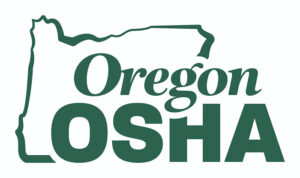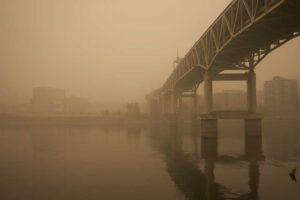February 2, 2022

The proposed heat illness prevention rule encompasses a variety of protective measures, including access to shade and cool water, work/rest schedules, information and training, and other preventive actions and plans. The proposed wildfire smoke rule includes an array of exposure assessments and controls, and training and communication steps.
Both rule proposals encompass protective measures for workers who rely on employer-provided housing, including as part of farm operations.
Development of the rule proposals – which build on temporary emergency rules adopted in summer 2021 – included extensive input and review by rule advisory committees, and employer and labor stakeholders. The rule development process also featured worker and community stakeholder listening sessions.
“These rulemaking efforts demonstrate our commitment to bolstering Oregon’s ability to protect workers – especially vulnerable workers who work outdoors – from extraordinary hazards that have been worsened by climate change,” said Andrew Stolfi, director of the Oregon Department of Consumer and Business Services (DCBS), which includes Oregon OSHA. “The dangers of extreme heat and wildfire smoke are not going away. That is why we must continue to build up our safeguards against them.”
Oregon OSHA is seeking public input on the proposed rules in a variety of ways through mid-March. The proposed heat rule will have three virtual public hearings:
- 6 pm Wednesday, Feb. 23
- 6 pm Thursday, Feb. 24
- 10 am Friday, Feb. 25
The proposed wildfire smoke rule will have three virtual public hearings at
- 6 pm Wednesday, March 2
- 6 pm Thursday, March 3
- 10 am Friday, March 4
Details on how to sign up for the hearings – as well as other options for making comments – are now available for heat and wildfire smoke.
“We welcome public input on these rule proposals, which are intended to increase protections for workers while creating greater clarity, practicality, and predictability for employers as they move forward,” said Lou Savage, interim administrator for Oregon OSHA. “These proposals reflect Oregon OSHA’s longstanding mission to advance safety and health for all Oregon workers.”
The division anticipates adopting the rules in April 2022, ahead of the grow and wildfire seasons. The rulemaking efforts are part of Oregon’s larger and ongoing work – initiated by Oregon Gov. Kate Brown – to mitigate the impacts of climate change.
Workers have a right to a safe and healthy workplace. That includes the right to raise concerns free from retaliation and to file a complaint with Oregon OSHA, which advances safety for all Oregon workers through enforcement, consultation, technical, and public education and training services. The Ombuds Office for Oregon Workers, an independent advocate, offers workers help in understanding their rights within workplace safety and health rules, and their rights within the workers’ compensation system.
Moreover, the DCBS Multicultural Communications Program provides outreach to communities with limited English proficiency. That outreach includes information about on-the-job safety and health. The program includes a toll-free phone number for Spanish-speaking Oregonians: 800-843-8086.
Oregon OSHA encourages careful readings of the heat and wildfire smoke rule proposals. The following are summaries of each rule proposal:
 Proposed heat illness prevention rule
Proposed heat illness prevention rule
The heat illness prevention rule would apply to any workplace – outdoors and indoors – where heat dangers are caused by the weather and where the heat index equals or exceeds 80 degrees Fahrenheit. It would exempt, for example, incidental heat exposures where an employee is not required to perform work for more than 15 minutes in any 60-minute period.
The requirements for employers would include:
- Sufficient shade that is immediately and readily available to employees.
- An adequate supply of cool drinking water – immediately and readily available to employees – with plenty of opportunities to stay hydrated.
- When the heat index equals or exceeds 90 degrees Fahrenheit – and work schedules and controls such as air conditioning do not reduce worker exposure below that level – then employers must engage in certain practices, including:
- Effective communication that puts workers in contact with supervisors as needed.
- Designation of one or more employees and equipment to call for emergency services.
- Implementation of a heat illness prevention work/rest schedule that is adjusted for effective protection.
- Written plans and procedures to gradually adapt employees to working in the heat. Known as acclimatization, this preventive measure would include such considerations as personal and environmental risk factors, and workers’ activity levels.
- A written heat-illness prevention plan that spells out what will be done to protect employees and is made available to employees.
- Annual training and information for all employees and supervisors in a language that is readily understood.
 Proposed protection from wildfire smoke rule
Proposed protection from wildfire smoke rule
The wildfire smoke rule applies to employers whose employees are – or will be – exposed to wildfire smoke where the ambient air concentration for fine particulate matter (also known as PM2.5) equals or exceeds an Air Quality Index (AQI) 101, which is unhealthy for sensitive groups. Sensitive groups include people with lung and heart problems; children younger than 18 and adults older than 65; pregnant women; and people with diabetes.
Exemptions include, for example, enclosed buildings in which the air is filtered by a mechanical ventilation system and the employer ensures certain exterior openings are closed, except when it is necessary to briefly enter or exit.
The requirements for employers would include:
- Determining and monitoring employee exposure at the start of each shift, using certain methods, to gauge the appropriate exposure controls.
- Providing annual training and information for all employees who may be exposed to wildfire smoke.
- Developing and implementing a system to communicate wildfire smoke hazards before exposure occurs.
- Using engineering or administrative controls to reduce employee exposure to less than an AQI of 101. Engineering controls include enclosed buildings or vehicles where the air can be adequately filtered. Administrative controls include relocating work to another outdoor location with better air quality or changing work schedules.
- Providing employees filtering facepiece respirators – approved by the National Institute for Occupational Safety & Health (NIOSH) – for voluntary use when exposure equals or exceeds an AQI 101. Such respirators include what is commonly known as an N95.
- Ensuring employees wear NIOSH-approved filtering facepiece respirators when exposure is at or above AQI 251. For respirators used exclusively for wildfire smoke, employers may implement the Wildfire Smoke Respiratory Protection Program – as outlined in the rule proposal’s appendix, instead of conducting medical evaluations and fit-testing under the Respiratory Protection Standard.
- Ensuring employees wear NIOSH-approved filtering facepiece respirators when exposure is at or above AQI 501. For respirators used exclusively for wildfire smoke concentrations at or above this level, employers must implement a complete respiratory protection program in line with the Respiratory Protection Standard.
Oregon OSHA develops and provides free resources to help employers comply with rules. The following list includes division resources addressing extreme heat and wildfire smoke, as well as other State of Oregon resources on those topics:
 Proposed heat illness prevention rule
Proposed heat illness prevention rule Proposed protection from wildfire smoke rule
Proposed protection from wildfire smoke rule